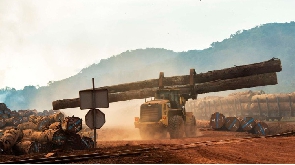African foresters want a change in government policies to allow easier trade in timber, taking advantage of available forests and to weed out exploitative trade routes.
They argue that archaic laws are, in fact, fuelling illegal harvesting and sale of trees which in turn cause losses to revenue agencies.
This is because, according to Dr Joshua Cheboiwo, the Director Kenya Forestry Research Institute (Kefri), transboundary timber trade in Africa is dominated by informal operators who often lack the necessary licenses, illegal activities involving under-declaration of quantities at borders, the use of unregulated and unofficial border points, and falsified documentation often result in huge losses in forest resources and revenues.
"Globally, the illegal timber trade amounts to, between $30 billion and $100 billion. In East Africa, Kenya-Tanzania illegal trade resulted in the loss of 70,000 hectares of forests and $10 million in foregone revenue," he said.
Africa is a net importer of forest products, with intra-African exports only accounting for 8 percent of global timber trading volumes.
“Africa boasts vast forestry resources and exports raw materials for processing abroad. We are almost third in material base in the world. But all we lack is investment in processing. Africa imports tertiary processed products valued at $4 billion with only a mere 10 percent intra-African trade,” added Dr Cheboiwo, who was the Keynote speaker during a regional forestry workshop held in Nairobi last month.
Sustainability question
The meeting organised by the African Forest Forum (AFF), a continental lobby for foresters, (July 3-7 2023), brought together 70 forestry stakeholders from 17 African countries to share information and experiences on forest conservation and tree-based ecosystem services for socioecological resilience against climate change.
Studies commissioned by AFF on the continent revealed that Africa’s export challenges in the forestry sector are complex.
The research papers uncovered a scarcity of documented trade data on forest products occurring between borders, for example.
They showed that the quantities and sales remain unknown, highlighting the concealed opportunity for governments to generate significant revenue.
According to Dr Cheboiwo, efforts have been made to condemn illegal logging activities, but less attention has been given towards implementing reforms.
Weak coordination among agencies in respective countries, conflicting laws and policies, poor enforcement regulations, collusion, and corruption contribute significantly to driving illegal timber trade, he argued.
International Union of Conservation of Nature (IUCN) and International Convention on Trade in Endangered Species (CITES), he said, had singled African Sandalwood and African Rosewood as the two species most affected by illegal trade in SSA countries for highly valued properties for perfumes and luxury furniture in India and China respectively.
Doris Mutta, a Senior Programme Officer at AFF explained that sustainable forest management should balance between the exploitation of forest resources and their positive impact on development, such as effectively managing timber and other forest production without compromising other vital ecosystem services like carbon sequestration, biodiversity preservation and water quality.
“Some nations are rich in natural resources, while others struggle with limited resources and rapid population growth and urbanisation.
“The promotion of intra-African investments and trade can have a significant impact on job creation and overall economic development across the continent. To achieve these goals effectively, African nations need to adopt measures under the AfCFTA that facilitate smooth movement of forest products and services across borders.”
Most of the illegal trade revolves around timber sourced from various species harvested from natural forests in West, East and Central Africa region with the latter standing out especially for its prized Mahogany hardwood species, valued for furniture and construction industries.
Significant deforestation
“The special Africa sandalwood and Africa Rosewood are largely found in scattered woodlands and forests in West, Central and Southern Africa and the high demand in Asia has resulted in high extraction from their natural habitats to near extinction,” he noted.
The foresters at the gathering examined the role of intra-Africa timber trade in continental socioeconomic development. According to the experts, if well managed, intra-Africa investments and trade can contribute significantly to employment creation and overall continental economic development.
Dr Cheboiwo said that in East Africa, Kenya faces significant deforestation challenges, partly due to governance problems and frequent logging bans. Kenya, stands out as the largest importer of timber and re-exporter of forest products to its neighbours. The lengthy logging bans in Kenya deterred potential investors, and hindered growth and manufacturing in this sector.
In contrast, Tanzania and Uganda have successfully attracted private investors to establish plantations resulting in a more rapid growth of their forestry, an are Kenya has lagged behind. Kenya recently lifted the logging ban, allowing harvesters to be permitted into forests under some form of guidelines.
Tanzania hosts the largest sawmill capacity. Several notable wood manufacturing facilities operate within this region, including Sao Hill with a capacity of 48,000 metric tonnes, Mufundi Paper Mill at 46,000 m3, Kilombero Valley Teak Company at 45,000 m3, and TANWAT at 20,000 m3. Tanzania is also a key exporter to Eastern and Southern African markets.
Three Kenyan companies, Rai Ply Group, Comply Industries, and Timsales, are major players involved in integrated saw milling operations along with plywood particle boards production.
Their operations have expanded into neighbouring countries like Tanzania and Malawi.
Across most of the continent, despite investor interest in private plantation forests, according to Dr Cheboiwo, land acquisition issues complicate the process. Land security concerns, conflicts over land between communities, regional and central governments, interfere with investment in Africa.
But there are issues of over-exploitation. “Of late we’ve been receiving investors from China in the veneer and plywood production sector.
Both in Tanzania and Uganda. There’s a lot of veneer production in the two countries for export, not for local consumption.
“But the practice doesn’t seem to be sustainable. They’re harvesting very young trees. And some of the investors who have moved from Tanzania to Uganda moved because they’ve wiped out resources in Tanzania,” said Prof Reuben Mwamakimbullah, CEO Davis Forestry Consultants in Tanzania.
Moreover, according to Prof Suzana Augustino, from the Department of Forest Engineering and Wood Sciences at Sokoine University of Agriculture, Morogoro, Tanzania, failure by States to account for the contribution of the forest ecosystem services to get their proper GDP value and contribution has kept the region’s forest resources undervalued and made resource management difficult.
“We also have an issue of incomplete and outdated regulations on forest products harvesting and trade. Inadequate enforcement of laws and regulations. Policy and legal frameworks are required to promote investment in industries, infrastructure development, and efficient timber trading practices,” said Prof Augustino.
“This is a region with a lot of wood but producing little industrial wood products. It mostly has small scale and very little production of veneer and plywood and an absence of pulp and paper production,” said AFF’s Executive Secretary, Prof Godwin Kowero, adding, “whereas North Africa, despite having limited forest resources within its borders, stands out as a noteworthy hub for pulp and paper manufacturing on the continent. The situation in Africa is such that where you don’t have a lot of forests, that's where you have the most processing.”
Africa News of Monday, 7 August 2023
Source: theeastafrican.co.ke

















